Regulatory Considerations for Controlled Correspondence Related to Generic Drug Chemistry
An analysis of controlled correspondence between generic-drug manufacturers and FDA reveals patterns in questions about specific drug chemistry topics and the response to information provided in FDA guidance documents.
Image Source/Getty Images

Controlled correspondence provides a crucial communication mechanism between FDA and the generic pharmaceutical industry. Such a mechanism allows the industry to seek for the agency’s input prior to the submission of an abbreviated new drug application (ANDA). On average, FDA has received more than 1000 controlled correspondences every year since the agency began responding to inquiries in 1992.
Controlled correspondence is defined as “a correspondence submitted to the agency, by or on behalf of a generic drug manufacturer or related industry, requesting information on a specific element of generic drug product development” (1). An effort has been made to data-mine correspondences related to generic-drug chemistry that were submitted in the past 10 years with the goal of identifying major categories of interest and determine areas where FDA can improve communication with the industry. This effort is expected to increase efficiency and thereby assure the fulfillment of the agency’s Generic Drug User Fee Amendments of 2012 (GDUFA) commitment to the industry, as elaborated below.
Under the GDUFA commitment (2), FDA will respond to:
- 70% of controlled correspondence in four months from date of submission in fiscal year (FY) 2015
- 70% in two months from date of submission in FY 2016
- 90% in two months from data of submission in FY 2017.
If the controlled correspondence requires input from the clinical division, one additional month will be added to the goals outlined above.
Several years ago, FDA established a webpage (3) and provided instructions to better guide the industry in submitting controlled correspondence. To further improve the efficiency of processing controlled correspondence, a draft guidance for industry entitled Controlled Correspondence Related to Generic Drug Development (1), was published in August 2014. In this guidance, controlled correspondence is defined and criteria are given for what correspondence is acceptable for submission to FDA. Pre-ANDA meeting requests,-questions related to pending ANDAs under review, inquiries not directly related to generic-drug development, or general, open-ended, or insufficiently detailed questions will not be considered as controlled correspondence. Requestors inquiring on matters under consideration by FDA (e.g., approval standards for complex products) will be notified, but no conclusive information will be given until the matter is settled by the agency. Moreover, the guidance states that requests for review of clinical protocols for in-vivo bioequivalence studies will remain excluded from GDUFA goal dates as these recommendations are covered by individual guidances. These well-defined limits are anticipated to reduce the volume of inquiries and allow allocation of FDA resources to providing timely answers to appropriate inquiries.
This retrospective analysis of chemistry-related controlled correspondence is another tool to aid in improving the agency’s response to the industry. Understanding trends in the content of these correspondences will allow FDA to improve communication, address gaps in guidance interpretation, and inform future guidance development. Increased clarity from FDA will further increase efficiency by reducing the volume of correspondences each year, thereby reducing strain on the agency’s resources.
Methods
The agency’s correspondence database was data-mined to identify chemistry-related correspondence received between January 2004 and May 2014. Preliminary search identified 754 correspondences labeled as chemistry related; among these, 173 were sub-labeled as meeting requests, biowaivers, bioequivalence, and citizen petition. However, they were not included in the further data analysis because they are not considered as chemistry-related correspondences under the new definition. Therefore, the final sample size was 581.
These correspondences were reviewed and assigned one of 15 categories and a number of relevant keywords. The questions and answers provided by the agency were summarized in a master spreadsheet based on receipt dates. The most frequently asked questions were identified and are discussed in this publication. A Python-based natural language processing tool (4) was then used to count keywords for further analysis of the categories and to generate a lexical dispersion plot to determine the location of each category within the text in a chronological order. In addition, review outcomes and commonly seen issues have been summarized and suggestions for improvement are provided.
Discussion and results
On average, the agency receives approximately 1200 correspondences yearly. Approximately 5-10% are related to generic-drug chemistry. The number of chemistry-related correspondences has increased steadily since 2011, as shown in Figure 1. Topics in these correspondences can be loosely grouped into 11 categories:
- Combination products
- Container closure system
- Dissolution
- Formulation
- Inactive ingredients
- Overage
- Stability
- Specifications
- 505(j) eligibility
- Post-approval changes
- Pre-approval changes.
Figure 1: Number of chemistry-related controlled correspondence (CC) received every year between 2004 and 2014.

Each correspondence was assigned to one category, and the number of correspondences under each category was counted and summarized in Figure 2. Categories with the highest number of counts include formulation, stability, specifications, and post-approval changes.
Figure 2: Number of chemistry-related controlled correspondences (CC) per category.
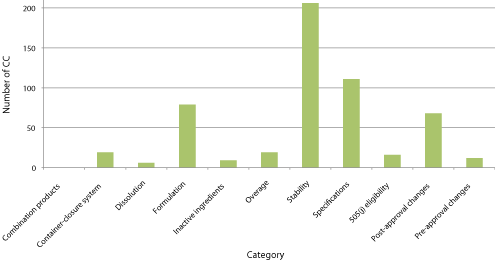
Formulation is a broad category, but generally consists of inquiries about API-related topics such as allowable particle size, salt stoichiometry, or synthetic route deviations from the reference listed drug (RLD); the presentation of the dosage form; and other allowable deviations from the RLD.
The specifications, post-approval changes, and stability categories were broken down into sub-categories to further elucidate trends.
Specifications is a broad topic, which includes questions related to residual solvents, identity, limits, drug master file (DMF), test method, validation, and impurity (see Figure 3A). While the counts in many of the subcategories were distributed relatively evenly, test method and impurity stood out as major topics. Test method questions were highly varied and case-specific. These questions sought specific recommendations on the procedure and/or data requirements for stability testing; API/excipient characterization and compatibility; in-process testing; quality requirements; and ANDA submission data requirements.
Figure 3A: Breakdown of the specifications categories. CC is controlled correspondence.
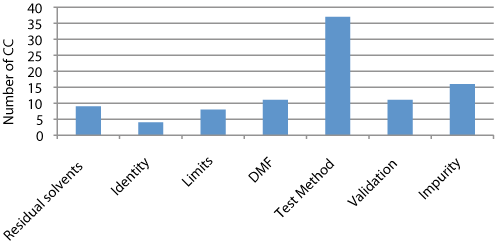
Inquiries about residual solvents or impurities generally requested advice on the limits or the types of solvents/impurities found with a particular API. The limits category catches all other inquiries regarding limits that are not pertaining to residual solvents or impurities; these questions largely requested advice on the setting of assay limits for the API.
Inquiries regarding post-approval changes (see Figure 3B) revolved almost exclusively around questions about which post-approval reporting category was most appropriate, followed by requests for advice on any other information or data that should be filed with the supplement(s). Questions in this category will no longer be considered as controlled correspondence; the draft Guidance for Industry: Controlled Correspondence Related to Generic Drug Development (August 2014) considers any questions related to a pending or approved ANDA as a review issue and outside the scope of controlled correspondence (1). However, the agency is trying to establish some mechanism to address general questions for approved ANDAs during the post-approval phase.
Figure 3B: Breakdown of post-approval changes. CC is controlled correspondence.

Stability questions were divided into subcategories (see Figure 3C) and pertained to requirements for batch size and requests for approval of bracketing or matrixing protocols. Batch number questions generally seek to clarify how many primary stability batches are required for supporting the ANDA submission given the requirements set forth in the June 2013 Guidance for Industry, ANDAs: Stability Testing of Drug Substances and Products (5). Because the release of this guidance and the subsequent May 2014 Guidance for Industry, ANDAs: Stability Testing of Drug Substances and Products Questions and Answers (6) generated many questions and represents a relatively major shift in FDA’s approach, further analysis of these controlled correspondences will be elaborated in a future publication.
Figure 3C: Breakdown of stability categories. CC is controlled correspondence
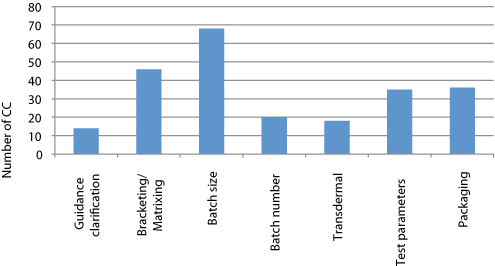
CLICK TABLE TO ENLARGE. Table I: Common questions and answers in controlled correspondences. PAS is prior approval supplement; CBE is changes being effected; ANDA is abbreviated new drug application; RLD is reference listed drug.
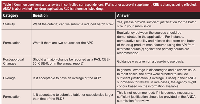
Most frequently asked questions
The most commonly posed questions across all categories were compiled in Table I. The most popular question was about reduced batch size(s): Firms requested for the agency’s concurrence on reduced primary batch sizes compared to the established pilot-scale size according to the International Conference on Harmonisation (ICH) definition. The criteria for an exception to the recommendations regarding minimum size for pilot scale for ANDA submission batch size reduction were established in the agency’s guidance (6):
- The RLD has an orphan drug designation.
- Use of a controlled substance allocated by the Drug Enforcement Administration.
- The test batch size is the same as the commercial batch size with the commitment that a prior approval supplement (PAS) will be provided when there is scale-up.
FDA did concur with the proposals for reduced batch sizes when they met one of the above criteria; however, in cases where the proposals used the high API cost or other financial/logistical constraints as justifications, the agency normally denied concurrence.
The second most popular question was regarding multiple API sources. The specific questions were broad, but generally related to whether different routes of synthesis are acceptable from two API sources in the same ANDA submission, whether it is acceptable to have different specifications and test methods for different sources of API, and how many exhibit/stability batches should be manufactured using the API from the alternate source(s). For the first two scenarios, FDA typically concurs with the proposals while recommending sufficient justifications to be included in the ANDA submission(s). Regarding the number of batches, the agency recommends comparative stability and release data from at least one batch of finished drug product produced from each alternate API source. It should be noted that the APIs in discussion are limited to small molecules; recommendations for complex drug substances or products (e.g., peptides, low molecular weight heparins, and biologics) can be different and would require considerations on case-by-case basis.
Another common question is the reporting mechanism for post-approval changes. Nearly all questions in the post-approval changes category were related to reporting category or what data should be submitted in support of the change. These questions have been addressed using a risk-based -approach following the general principles prescribed by the agency’s guidances on post-approval changes (7, 8).
Questions on overage were almost exclusively related to whether or not the firm could produce a drug product with an overage of the API. In most circumstances, the overage proposal was not approved. As set forth in the Guidance for Industry: Q8(R2) Pharmaceutical Development (January 2009) (9), the use of an overage to compensate for degradation during manufacture or a product’s shelf life, or to extend shelf life, is discouraged. Many firms claim to have found an overage in the RLD; however, this may not be a sufficient justification for overage because the RLDs may have used a different product design and/or manufacturing processes. Given that only a limited amount of information is typically provided in these correspondences, FDA typically considers the use of overage as a review issue to be evaluated within the full context of the ANDA(s); therefore, the firms should provide sufficient justifications in the ANDA submission(s) if overage is used.
The fifth most popular question was whether it is acceptable to formulate a tablet or capsule size larger than that of the RLD. It is generally recommended to formulate generic solid oral dosage forms to be similar in size to the RLD to increase patient compliance and reduce the risk of dysphagia. Further details are discussed in the Guidance for Industry: Size, Shape, and Other Physical Attributes of Generic Tablets and Capsules (10). Somewhat similar to the use of overage, the agency typically states in the responses that deviations (especially when larger) should be justified in the ANDA submission. Proper justifications should at least include why a larger size is necessary, and how the firm will circumvent dysphagia and patient-compliance issues. Arguments based on patent infringement or manufacturing limitations are not considered appropriate.
CLICK IMAGE TO ENLARGE. Figure 4: Popularity of categories over time. The publication time points of three guidance documents: A. CMC Postapproval Manufacturing Changes to be Documented in Annual Reports (March 2014); B. ANDAs: Stability Testing of Drug Substances and Products (June 2013); C. Stability Testing of Drug Substances and Products: Questions and Answers (May 2014) are indicated in the figure.

Chronological correlation
It is helpful to visualize when a topic becomes popular in time. These time points can signal when guidances have accurately conveyed information or may alert the agency about unclear guidance language or recommendations. A lexical dispersion plot (Figure 4) displays words in sequential order within a text to visualize the location of keywords within the text. Each stripe represents the instance of a word (the category) and each row represents the entire text. Simultaneously identifying the location of the years 2004-2014 within the text allowed for correlation between the occurrence of each category to the date that the correspondence was submitted.
This type of chronological correlation shows a heightened interest in specification, formulation, and overage questions beginning in 2012. Questions regarding post-approval changes have remained fairly steady. The Guidance for Industry: CMC Postapproval Manufacturing Changes to Be Documented in Annual Reports (8) was published in May 2014; correspondences will be monitored using such a chorological correlation to assess how well such a guidance document would guide the industry. Figure 4 shows a sharp increase in stability-related controlled correspondence beginning in late 2012, which loosely correlated with the publication of the stability guidance document (5) and its companion question and answer document (6). Given that many questions were about the number and sizes of primary stability batches, FDA may use this information to guide further policy/guidance development or updates.
CLICK IMAGE TO ENLARGE. Figure 5: Breakdown of specifications category and popularity over time. The publication time points for the guidance documents: A. Residual Solvents in Drug Products Marketed in the United States (November 2009); B. ANDAs: Impurities in Drug Substances (June 2009); and C. ANDAs: Impurities in Drug Products (November 2010) are indicated in the figure.

Furthermore, the evaluation of the frequency of inquiries on a topic over time can indicate how well the agency’s guidance/policy addressed the related topics. For example, questions regarding acceptable limits for and test methods of residual solvents (see Figure 5) were most popular in 2008 and 2009 and then decreased after 2009, corresponding to the release of the Guidance for Industry: Residual Solvents in Drug Products Marketed in the United States (11) in November 2009. From 2012, no more residual solvents inquiries are recorded. Similarly, the number of questions on impurities dramatically dropped in 2009 and 2010, concurrent with the publication of two impurity-related guidance documents (12, 13).
Observations and recommendations
Based on the observations during the review of these correspondences, commonly seen submission issues include:
- Vague, general, or poorly-worded questions
- Imprecise language and/or misused terms
- Questions that make incorrect assumptions
- Too much unnecessary information provided.
The agency strongly recommends the firms:
- Provide clear, concise questions
- Thoroughly research the question before drafting the controlled correspondence, including visiting the FDA website for published guidances and materials
- Provide relevant information clearly in the letter, including, at a minimum, dosage form
- Do not assume that the agency will correct any incorrect assumptions/information.
With these recommendations considered, a general workflow for proper assembly of controlled correspondences is provided in Figure 6.
Figure 6: Recommendations on how to assemble a controlled correspondence (CC).
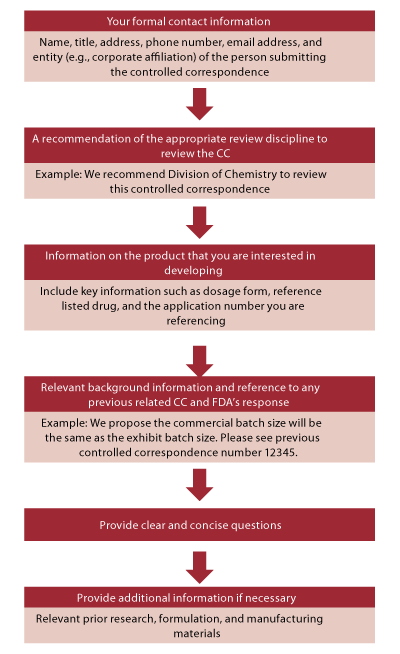
Conclusion
Controlled correspondence is a crucial route of communication between FDA and the generic-drug industry to facilitate the development of generic-drug products. Therefore, the agency has agreed to specific program enhancements and performance goals for addressing these correspondences, as set forth in the GDUFA Commitment Letter (2). As part of the effort, this data-mining exercise was conducted to identify gaps and potential continual improvements in chemistry-related correspondences. The findings and observations here can provide valuable reference to both FDA and the generic-drug industry. From these observations, the agency can gain better understanding of how its guidances and policies are received and further gauge the needs and concerns of the industry. Further interpretation of certain guidances and policies are provided here so that the industry can be more efficient in submitting correspondences and developing generic-drug products.
References
1. FDA, Guidance for Industry: Controlled Correspondence Related to Generic Drug Development (Draft). (Rockville, MD, August 2014).
2. FDA, Generic Drug User Fee Act Program Performance Goals and Procedures (Rockville, MD, 2012) online, accessed July 15, 2015.
3. FDA, Recommendations for Improving Submissions of a “Controlled Correspondence” to the Office of Generic Drugs (Rockville, MD, 2012) online, accessed July 15, 2015.
4. E. Loper et al., Natural Language Processing with Python Analyzing Text with the Natural Language Toolkit. 1st ed. (Sebastopol, CA, 2009).
5. FDA, Guidance for Industry: ANDAs: Stability Testing of Drug Substances and Products (Rockville, MD, June 2013).
6. FDA, Guidance for Industry: ANDAs: Stability Testing of Drug Substances and Products Questions and Answers (Rockville, MD, May 2014).
7. FDA, Guidance for Industry: Changes to an Approved NDA or ANDA (Rockville, MD, April 2004).
8. FDA, Guidance for Industry: CMC Postapproval Manufacturing Changes To Be Documented in Annual Reports (Rockville, MD, March 2014).
9. FDA, Guidance for Industry: Q8(R2) Pharmaceutical Development (Rockville, MD, Nov. 2009).
10. FDA, Guidance for Industry, Size, Shape, and Other Physical Attributes of Generic Tablets and Capsules (Rockville, MD, June 2015).
11. FDA, Guidance for Industry: Residual Solvents in Drug Products Marketed in the United States (Rockville, MD, Nov. 2009).
12. FDA, Guidance for Industry: ANDAs: Impurities in Drug Substances (Rockville, MD, June 2009).
13. FDA, Guidance for Industry: ANDAs: Impurities in Drug Products (Rockville, MD, Nov. 2010).
The authors are with the Center for Drug Evaluation and Research, FDA. Contact: Geoffrey Wu, PhD, Geoffrey.Wu@fda.hhs.gov.
Disclaimer: This article reflects the views of the authors and should not be construed to represent FDA’s views of policies.
Article DetailsPharmaceutical Technology's APIs, Excipients, and Manufacturing Supplement
Vol. 39, No. 18
Pages: s27–s33
Citation:
When referring to this article, please cite it as G. Wu et al, “Regulatory Considerations for Controlled Correspondence Related to Generic Drug Chemistry," Pharmaceutical Technology APIs, Excipients, and Manufacturing Supplement 39 (18) 2015.

2 Commerce Drive
Cranbury, NJ 08512
All rights reserved.